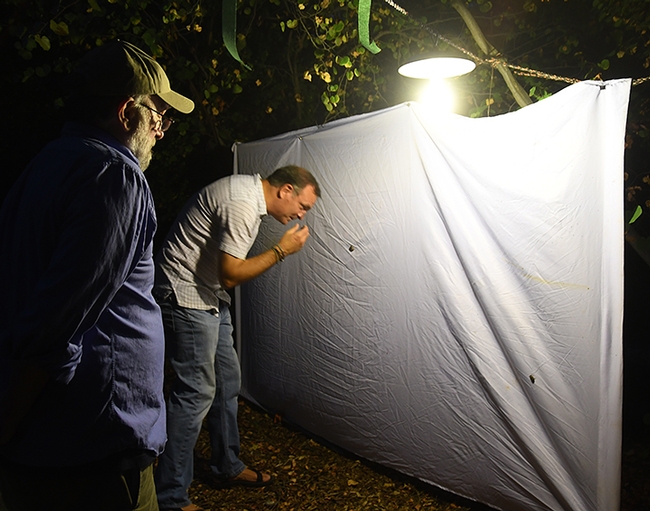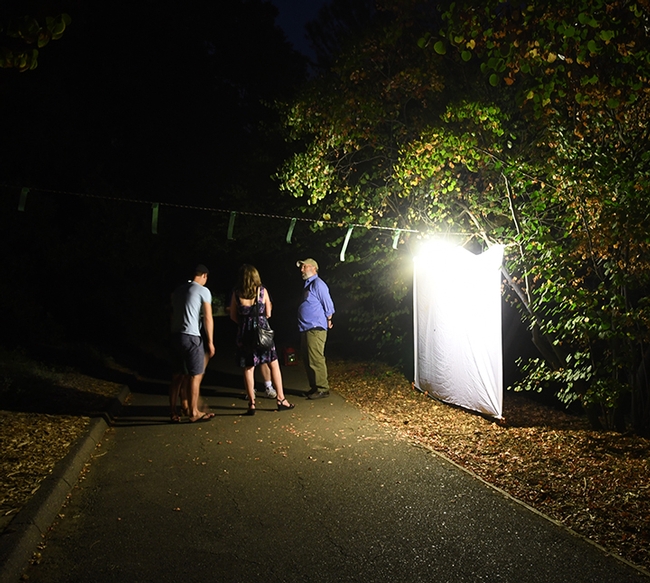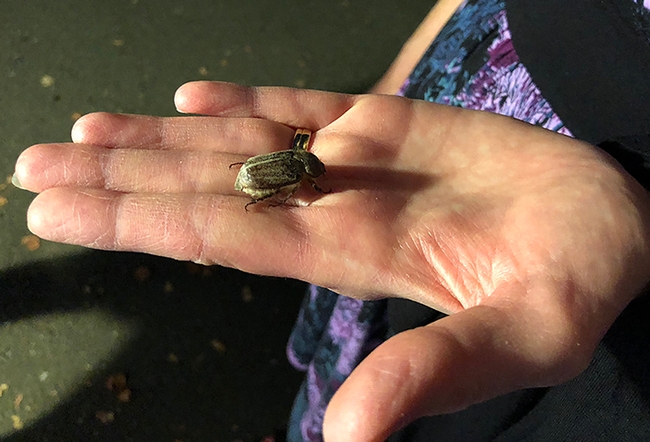- Author: Kathy Keatley Garvey

Spiders--especially jumping spiders, crab spiders and orb weavers--fascinate me. They've been around for 400 million years and are cunning, skillful predators. I don't relish them eating a honey bee in our pollinator garden, but everything has to eat. If I were in charge of their culinary habits, though, I'd point them in the general direction of a delicious stink bug or a scrumptious green bottle fly or a tasty lygus bug. And ask them, pretty please, to leave my honey bees alone.
Still, many people fear spiders. Arachnophobia is a common phobia, but there are five good reasons to like spiders, according to Jason Bond of the UC Davis Department of Entomology and Nematology.
The five good reasons to like spiders?
- Spiders consume 400-800 million tons of prey, mostly insects, each year. Humans consume somewhere around 400 million tons of meat and fish each year.
- Spider silk is one of the strongest naturally occurring materials. Spider silk is stronger than steel, stronger and more stretchy than Kevlar; a pencil thick strand of spider silk could be used to stop a Boeing 747 in flight.
- Some spiders are incredibly fast – able to run up to 70 body lengths per second (10X faster than Usain Bolt).
- Athough nearly all 47,000-plus spider species have venom used to kill their insect prey, very few actually have venom that is harmful to humans.
- Some spiders are really good parents –wolf spider moms carry their young on their backs until they are ready to strike out on their own; female trapdoor spiders keep their broods safe inside their burrows often longer than one year, and some female jumping spiders even nurse their spiderlings with a protein rich substance comparable to milk.
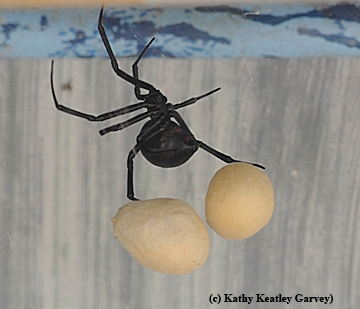
Following his presentation, activity stations will be open in the Bohart Museum where visitors can “Assemble an Arachnid,” “Create a Chelicerate,” “Cribellate vs. Ecribellate Silk,” “Catch a Moth,” “Eat Like a Spider,” and learn about "Spider Senses" and “Trapdoor Specifics.”
Visitors will see live specimens and specimens in alcohol. They'll learn the differences between woolly silk and sticky silk. They'll see the Bohart arachnids--tarantulas--and hold some of the non-arachnids, including walking sticks and Madagascar hissing cockroaches.
“Spiders are an incredibly diverse group with more than 50,000 species described with probably another 200,000 remaining to yet be discovered,” says Bond, who joined the department last July from Auburn University, Alabama. “They are quite ancient, with fossils dating back well over 300 million years and are known to be exclusively predatory.”
Bond joined the UC Davis faculty after a seven-year academic career at Auburn University, Ala. He served as professor of biology and chair of the Department of Biological Sciences from January 2016 to July 2018, and as curator of arachnids and myriapods (centipedes, millipedes, and related animals) at the Auburn University Museum of Natural History, from August 2011 to July 2018.
The Bohart Museum of Entomology, directed by Lynn Kimsey, professor of entomology at UC Davis, houses nearly eight million insect specimens collected from all over the world. It also includes a gift shop and a live “petting zoo,” comprised of Madagascar hissing cockroaches, stick insects and tarantulas.
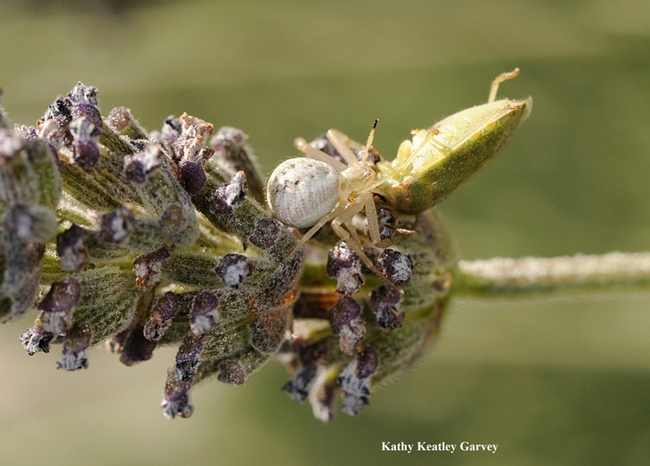
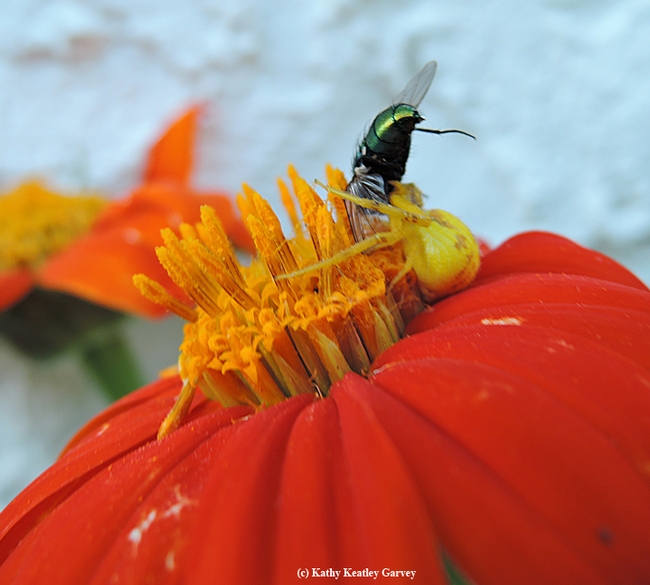
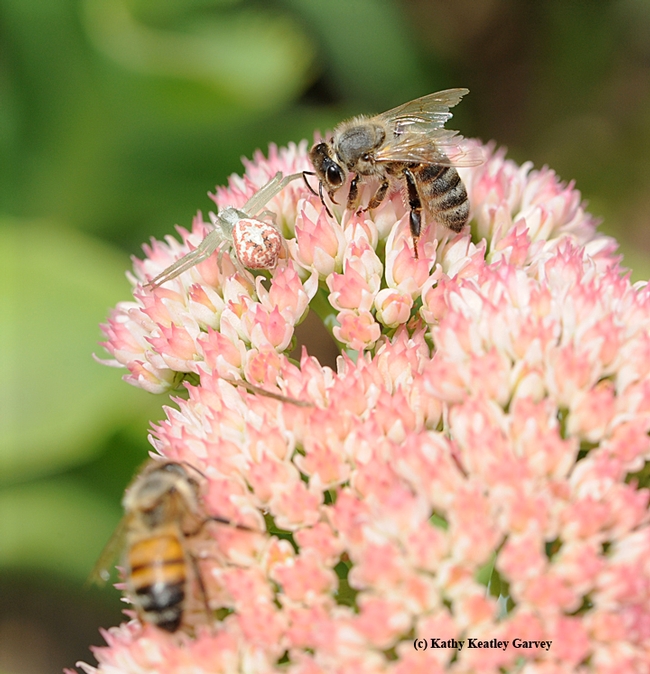
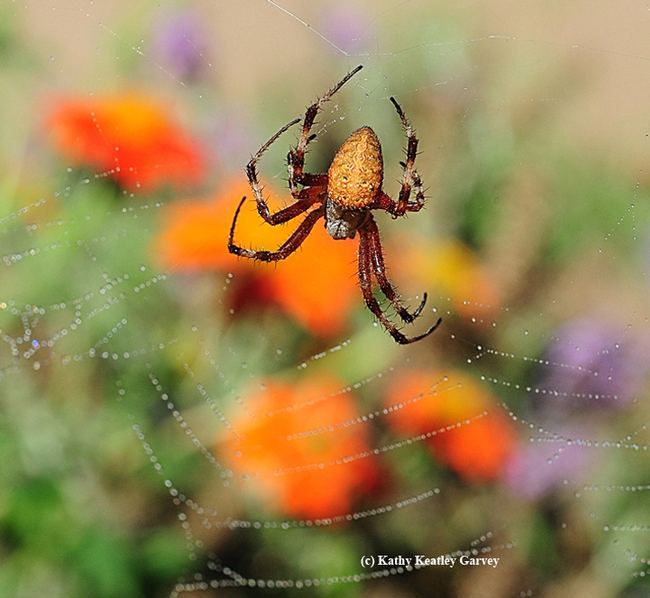
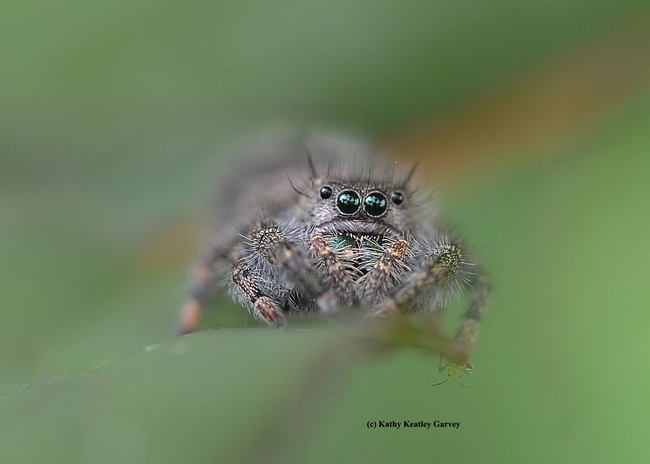
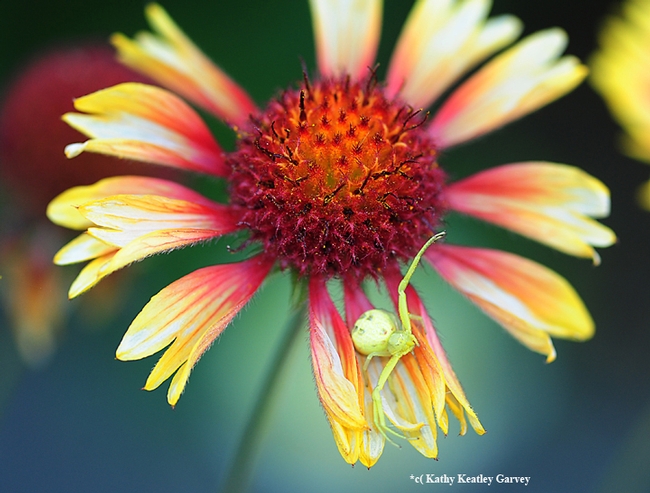
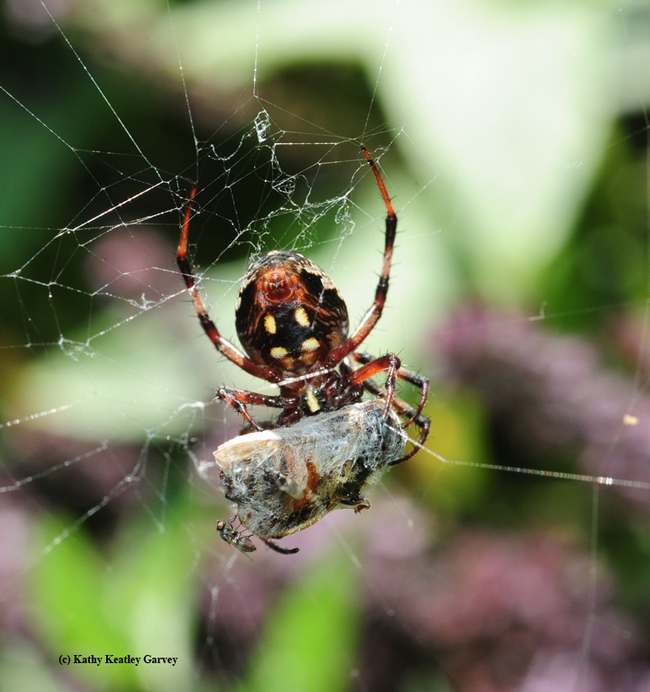
- Author: Kathy Keatley Garvey
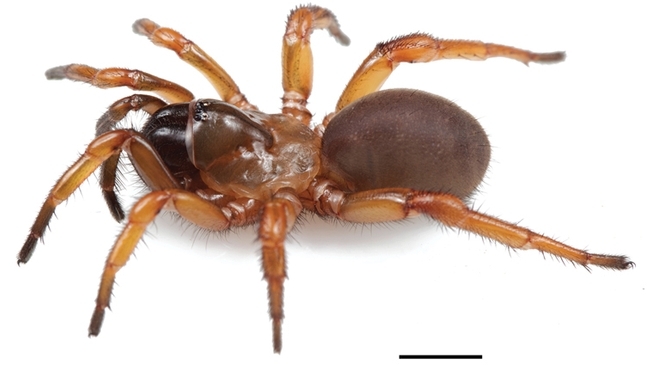
But have you heard of the "Eight-Legged Wonders?"
You won't want to miss the "Eight-Legged Wonders" open house from 1 to 4 p.m., Saturday, March 9 at the Bohart Museum of Entomology, University of California, Davis.
If you miss it, you'll miss your opportunity to learn about spiders from an international expert, and miss the opportunity to "Assemble an Arachnid," "Create a Chelicerate" and "Eat Like a Spider."
Eat like a spider? Tabatha Yang, Bohart Museum's education and outreach coordinator, related you'll get to “slurp up soggy cookies.”
The event, free and family friendly, takes place primarily in Room 1124 of the Academic Surge Building on Crocker Lane.
Arachnid expert Jason Bond, who is the Evert and Marion Schlinger Endowed Chair in Insect Systematics in the UC Davis Department of Entomology and Nematology, will present a 10-minute slide show at 1 p.m. in the Museum of Wildlife and Fish Biology classroom, located on the first floor of the Academic Surge Building, next to the Bohart Museum.
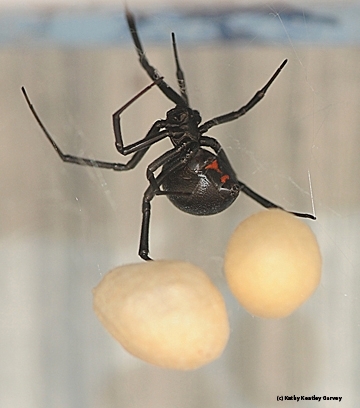
You'll see live specimens and specimens in alcohol. You'll learn the differences between woolly silk and sticky silk. You'll also see the Bohart arachnids--tarantulas--and hold some of the non-arachnids, including walking sticks and Madagascar hissing cockroaches.
“Spiders are an incredibly diverse group with more than 50,000 species described with probably another 200,000 remaining to yet be discovered,” says Bond, who joined the department last July from Auburn University, Alabama. “They are quite ancient, with fossils dating back well over 300 million year and are known to be exclusively predatory. In fact, based on a study published last year, spiders are estimated to consume somewhere in the neighborhood of 800 million tons of insect biomass.”
“To capture insects, and other prey item--sometimes even vertebrates--most spiders employ silk and venom to snare and subdue their victims,” the arachnologist says. “Spider silk is an amazingly strong, proteinaceous material that is produced in many different forms; venoms are likewise complex, diverse proteins. All of this to say – what's not to like – spiders are a tremendously ecological important predatory group, that has persisted on the planet for 100s of millions of years and employ a remarkable suite of silks and venoms to make a living.”
Highly respected for his expertise on spiders, Bond served as the plenary keynote speaker at the 2016 International Arachnological Congress, and also keynoted the 2012 European Arachnological Congress.
Born in Johnson City, Tenn., Bond is a U.S. Army veteran who served for a number of years as a UH-60 Blackhawk helicopter crew chief. He received his bachelor's degree in biological sciences, cum laude, in 1993 from Western Carolina University, Cullowhee, and his master's degree in biology in 1995 from Virginia Polytechnic Institute and State University, Blacksburg. He earned his doctorate in evolutionary systematics and genetics in 1999 from Virginia Tech.
All three degrees focused on arachnids. His undergraduate thesis involved silk spigots; his master's degree, systematics of the spider genera Mallos and Mexitlia; and his doctoral dissertation covered “Systematics and Evolution of the Californian Trapdoor Spider Genus Aptostichus Simon (Araneae: Mygalomorphae: Cyrtaucheniidae).”
What drew him to arachnology? As an undergraduate researcher at Western Carolina University, Bond worked with noted arachnologists Jackie Palmer and Fred Coyle. “My first research project was related to functional morphology (evolution of the spinning apparatus in more primitive spiders) but quickly shifted to systematics and taxonomy.”
Bond joined the UC Davis faculty after a seven-year academic career at Auburn University, Ala. He served as professor of biology and chair of the Department of Biological Sciences from January 2016 to July 2018, and as curator of arachnids and myriapods (centipedes, millipedes, and related animals) at the Auburn University Museum of Natural History, from August 2011 to July 2018.
It was at Auburn University where Bond and his colleagues discovered a new species of trapdoor spider that drew international attention and a news story in the Huffington Post. They named it Myrmekiaphilia tigris, or the Auburn Tiger Trapdoor Spider, in honor of the university's costumed tiger mascot, Aubie. The discovery was exciting but not “surprising,” Bond told the Huffington Post, pointing out that it took taxonomists about 250 years to describe about 1.8 million plants and animals, and that this scratches the surface of what scientists estimate to be between five and 30 million overall species on earth.
The amazing eight-legged wonders!
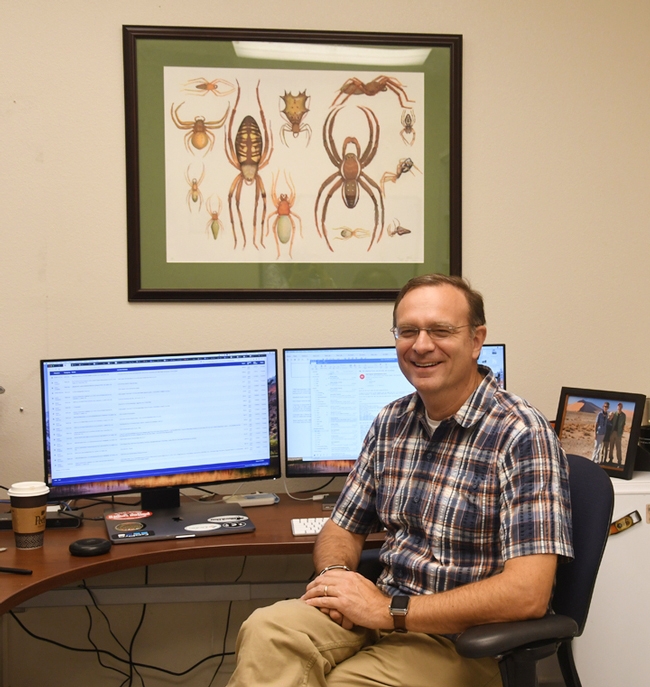
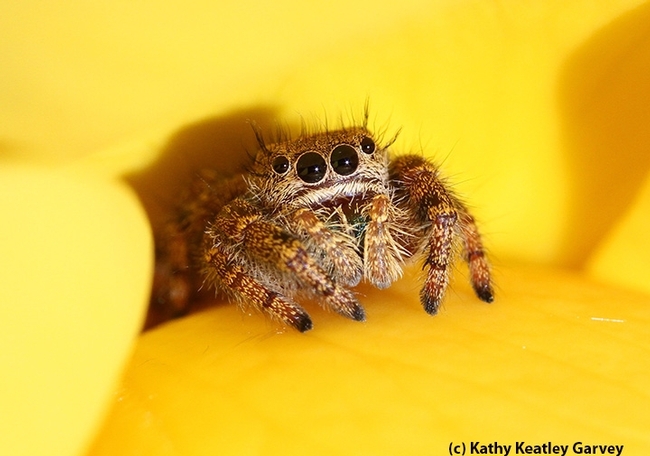
- Author: Kathy Keatley Garvey
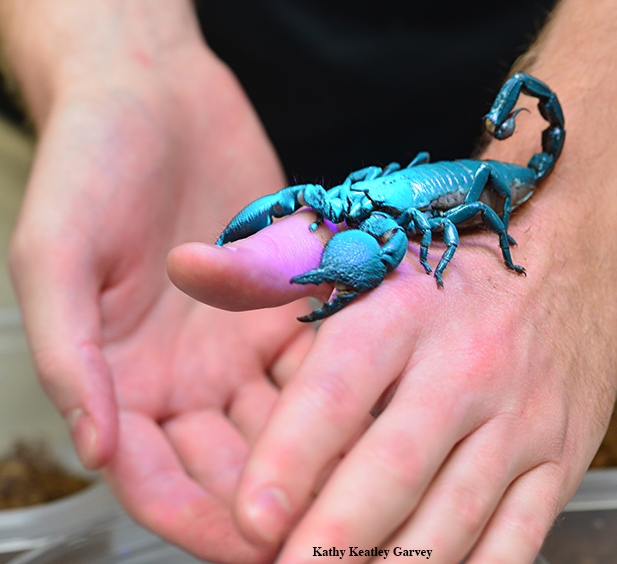
But did you know that scorpions are the oldest living terrestrial arthropods on the planet--that they're approximately 400 million years old? And that these "living fossils" were here before the dinosaurs?
And, did you also know that scorpions are the only arachnids that give birth to live young?
All fascinating facts.
Scorpion scientist Lauren Esposito of the California Academy of Sciences, will reveal those facts--and much more--when she discusses her research at the UC Davis Department of Entomology and Nematology seminar on Wednesday, Feb. 27.
Esposito, assistant curator and Schlinger chair of Arachnology at the California Academy of Sciences, San Francisco, will speak on "Evolution of New World Scorpions and Their Venom" from 4:10 to 5 p.m. in 122 Briggs Hall. Host is Jason Bond, Evert and Marion Schlinger Endowed Chair in Insect Systematics, UC Davis Department of Entomology and Nematology.
Scorpions are just about everywhere; they're found on every continent except Antarctica. In fact, they're found in every ecosystem on the planet, from cave systems below sea level to the peaks of the Alps and the Andes, Esposito says. Although scientists have described 2,200 species of scorpions, Esposito estimates that this number encompasses only 60 percent of the group's total diversity. In her research, she's trying to fill in that taxonomic gap.
Scorpions first drew Esposito's interest in her childhood. Both her parents are biologists. She remembers visiting her grandparents on a remote island in the Bahamas. “The most dangerous things on the island were ants and scorpions, so it was a pretty ideal place for a child to explore,” she quips on the Cal Academy website.
Esposito served a summer undergraduate internship in arachnology at the American Museum of Natural History (AMNH), and did volunteer work at a field station in the Chihuahuan Desert. She returned to AMNH to complete her doctorate in arachnology, and then completed a postdoctoral fellowship studying the biogreography of scorpions in the Caribbean. In 2015, she accepted an arachnologist position at the Cal Academy.
"For the past several years, Esposito has studied the evolution and geographical distribution of scorpions in the Caribbean," according to the Cal Academy website. "She suspects the string of islands played a significant but underappreciated role in producing the biodiversity currently found in North and South America. Because scorpions are essentially 'living fossils,' they're ideal organisms to study to decipher this larger relationship. Understanding the biodiversity of this region in a time of rapid agricultural development is a key step toward sustaining it for sustaining it for future generations."
Esposito marvels that a single scorpion "can carry the genes for more than 200 unique venoms in its DNA." She describes those venom varieties as "like protein cocktails, mixed to affect specific mammals, insects, and crustaceans."
“Researchers think that scorpions eject venoms with different compositions depending on the scenario," she says. "If they encounter a predator, they'll eject one combination, and if they encounter prey, a different one.” The venom's effects? Pain, temporary paralysis, or death.
Esposito focuses her research on the evolution of scorpion venom alongside the evolution of scorpions. This makes her unique among venom experts, who are often toxicologists or biochemists studying its chemistry, according to the Cal Academy website.
“Looking at how this venom diversity evolved helps us understand how one creature can evolve the ability to strike hundreds of specific targets,” explains Esposito. “There's a kind of evolutionary arms race happening between scorpions and mammals, particularly with predatory, nocturnal scorpion mice.”
Cal Academy's YouTube video on The Anamolies: Venom Race points out that although "the stings of most scorpions are harmless to humans, a select few can be fatal. Striped bark scorpions, a group of species found in the southwestern U.S. and northern Mexico, inflict on average 100,000 stings and, until recently, caused more than a thousand deaths each year in Mexico alone. While finding a treatment to this public health concern has been a driving force behind studies of bark scorpion venom, there was one very basic question that had scientists scratching their heads: Why and how would such a tiny creature pack such a lethal punch? Now, researchers, including Lauren Esposito, curator of Arachnology at the California Academy of Sciences, think they've found the answers in the interplay between a diminutive but dauntless predator—a mouse that has a particular taste for these venomous invertebrates—and the scorpions' own genetic makeup."
Check out these other incredible videos on the Cal Academy website:
Medical entomologist Geoffrey Attardo, assistant professor, UC Davis Department of Entomology and Nematology, coordinates the weekly seminars.
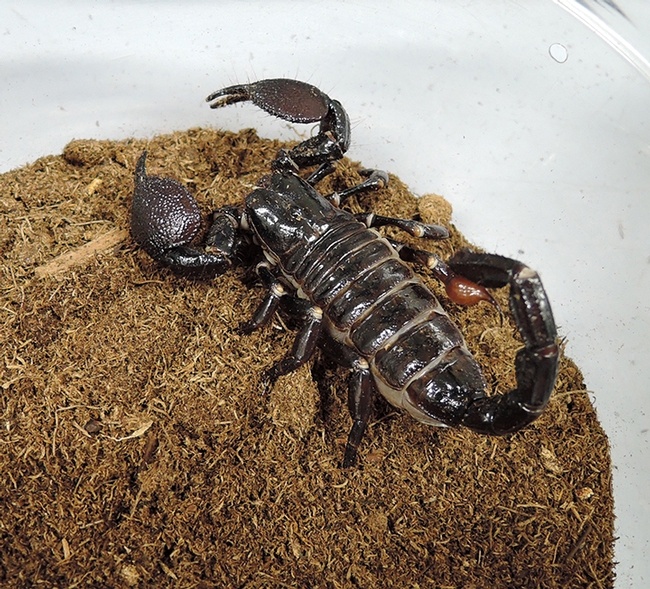
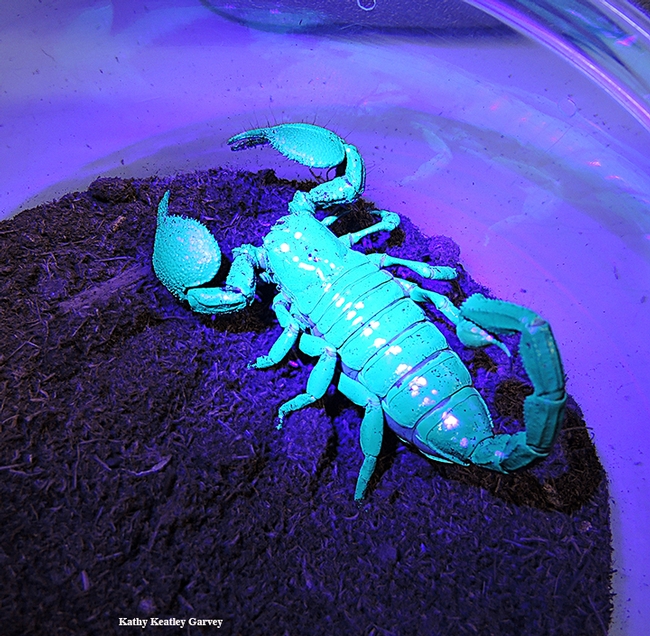
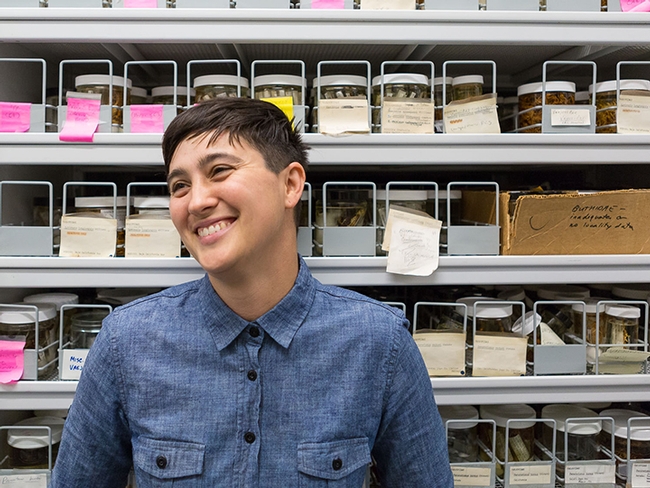
- Author: Kathy Keatley Garvey
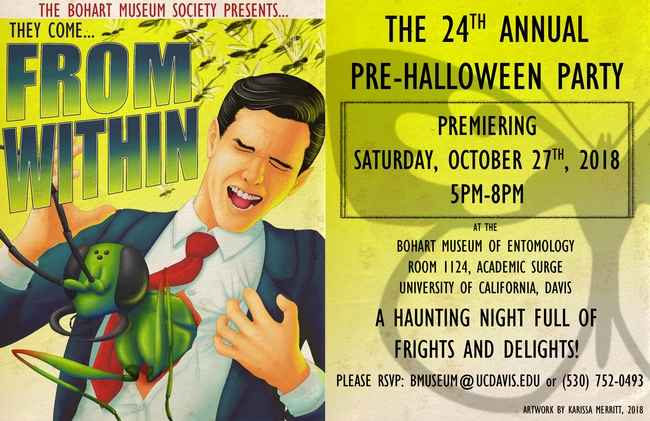
The Bohart Museum Society hosted the Bohart Museum of Entomology's 24th annual pre-Halloween party on Saturday, Oct. 27 at the University of California, Davis, billing it as “They Come From Within" and promising a “haunting night full of frights and delights."
It was.
You can thank the emerald cockroach wasp or jewel wasp (Ampulex compressa), an entomophagous parasite, for that! It is known for its unusual reproductive behavior, in which it stings a cockroach and then uses it as a host for its larvae, eating it alive.
That was the critter depicted on the invitation.
UC Davis entomology undergraduate student and talented artist Karissa Merritt created the much-applauded, wasp-inspired invitation. "For this year's Bohart Halloween party invite, I set out to create an original--fake--movie poster, inspired by old B-movies such as 'Them' and 'Invasion of the Saucer Men,'" she explained. "I really wanted the invitations to grab people's attention with the bright colors, and grotesque horror as a giant jewel wasp--based on Ampulex compressa--emerges from a living man's chest."
It did. It also grabbed the attention of UC Davis entomology doctoral candidate Charlotte Herbert Alberts, who studies Asilidae (Assassin flies) with her major professor, Lynn Kimsey, director of the Bohart Museum and professor of entomology. "I made my costume to honor Karissa's incredible drawing of the invitation," said Charlotte, who anticipates receiving her Ph.D in 2020. Her husband, George, dressed as Dracula. Their Brittany Spaniel, Westley, declined to wear a dinosaur costume and came as himself.
At the entrance, assorted mustaches and masks commanded a table. A sign urged people to "write a name tag, yet disguise yourself if you aren't in costume." (With the addition: "I know it doesn't make sense; just humor us.")
Among those coming as themselves were entomologist Jeff Smith, who curates the butterfly and moth collection; his wife, Cathy; and Bohart associate and naturalist-photographer Greg Kareofelas.
Senior museum scientist Steve Heydon wore an orange jumpsuit lettered with "Department of Corrections" while his wife, Anita, came dressed as a police officer, complete with badge and handcuffs.
Forensic entomologist Robert "Bob" Kimsey, husband of Lynn Kimsey, donned his traditional ghillie suit.
Bohart Museum director Lynn Kimsey cut a 72nd anniversary cake, a red-velvet, chocolate-frosted cake decorated with--what else?--bugs! After all, the Bohart Museum houses some 8 million specimens, plus a live "petting zoo" of Madagascar hissing cockroaches, walking sticks, tarantulas and praying mantids, as well an insect-themed gift shop.
Meanwhile evolutionary ecologist Scott Carroll, at 6'11", towered over everyone. "I can pick him out in a crowd," quipped his wife, entomologist Jenella Loye.
(See tomorrow's Bug Squad blog for more Halloween images, including the pinata breaking game. The pinata? A replica of a monarch chrysalis.)
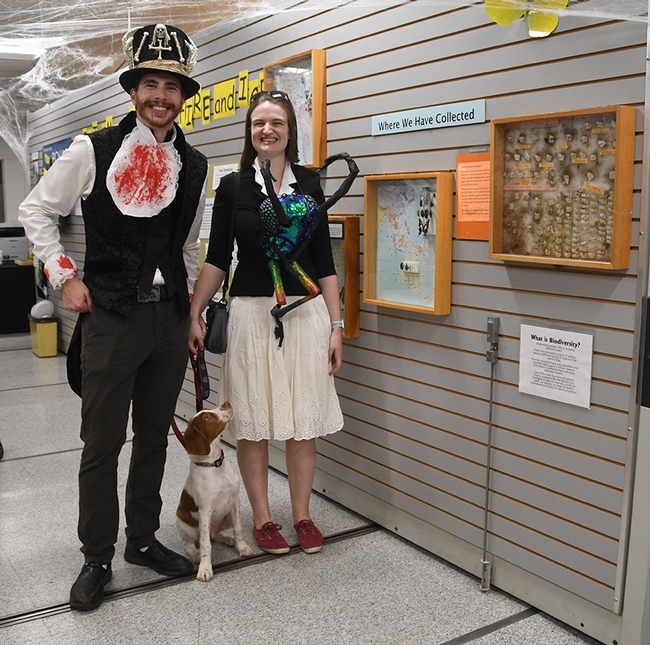
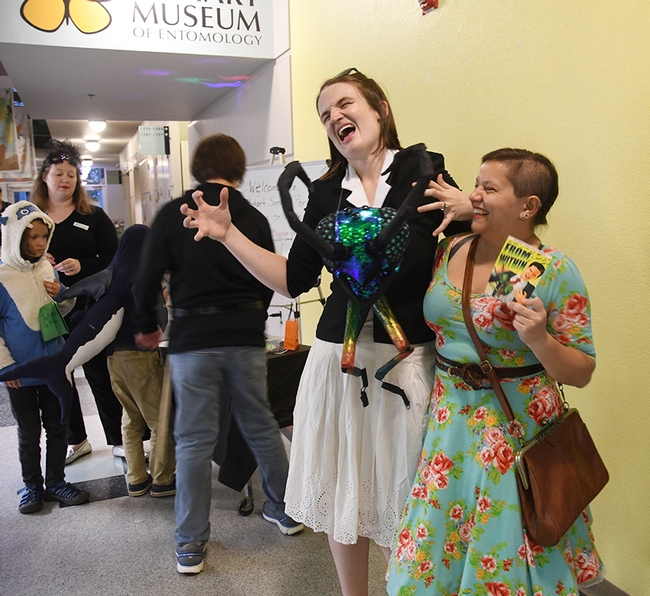
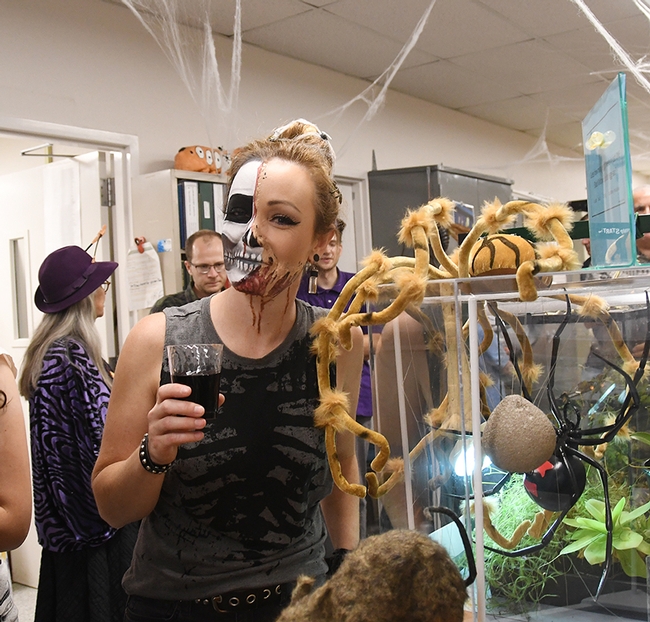
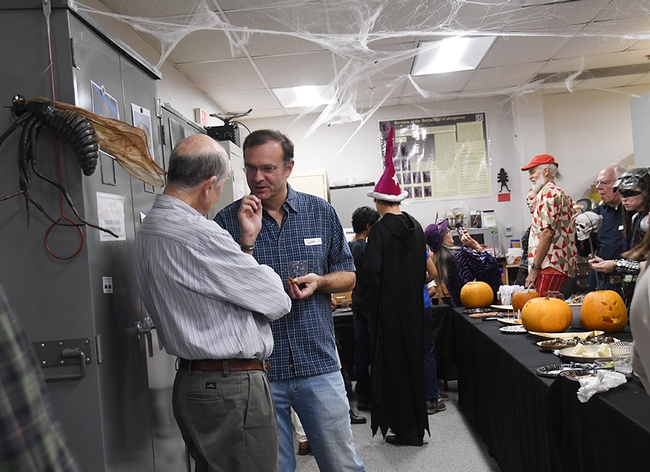
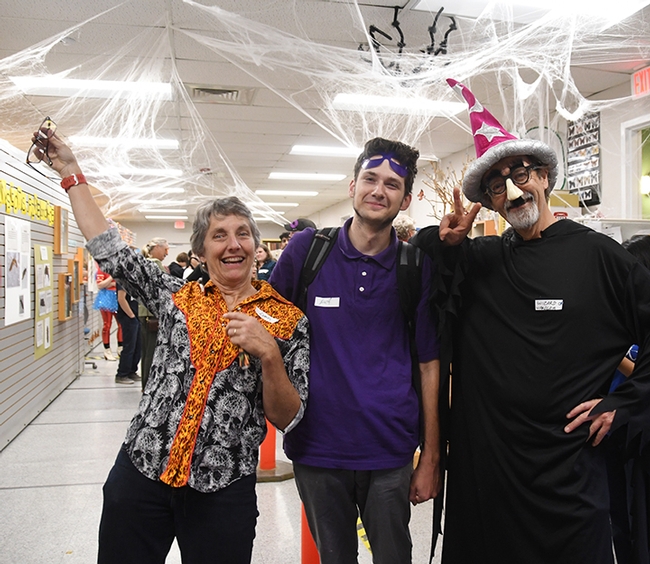

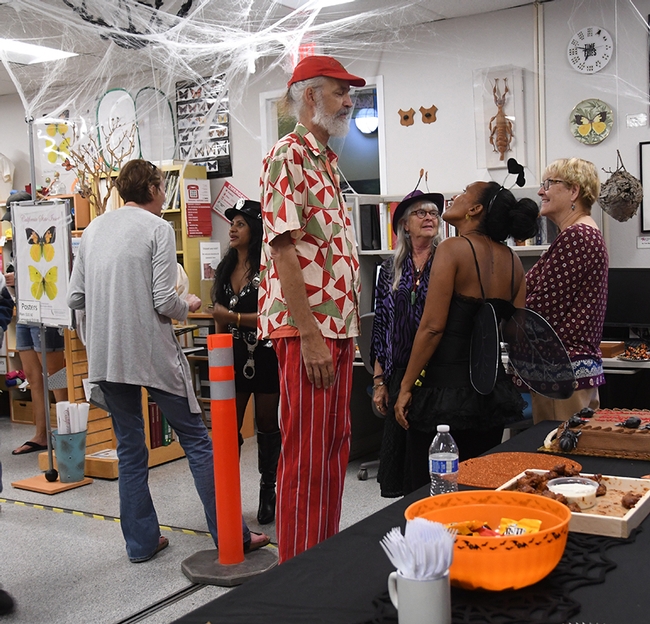
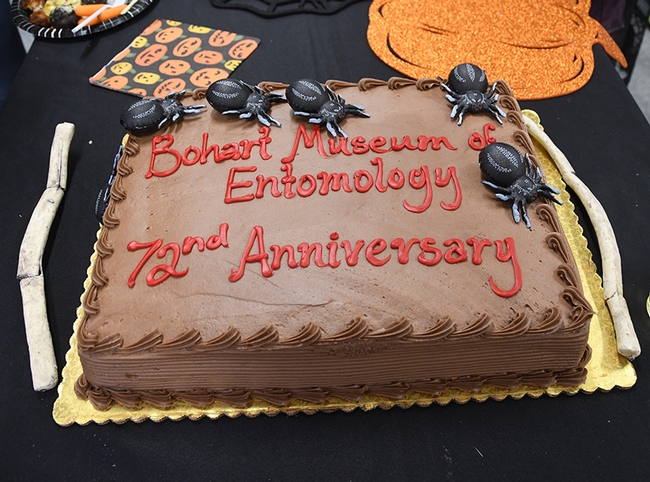
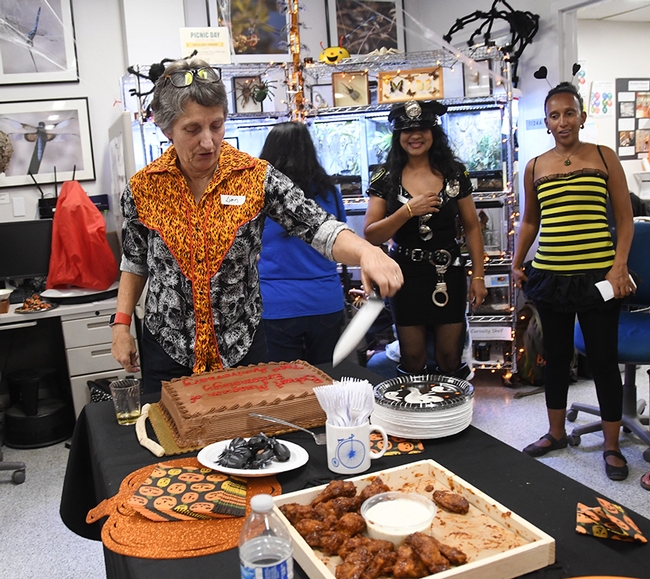
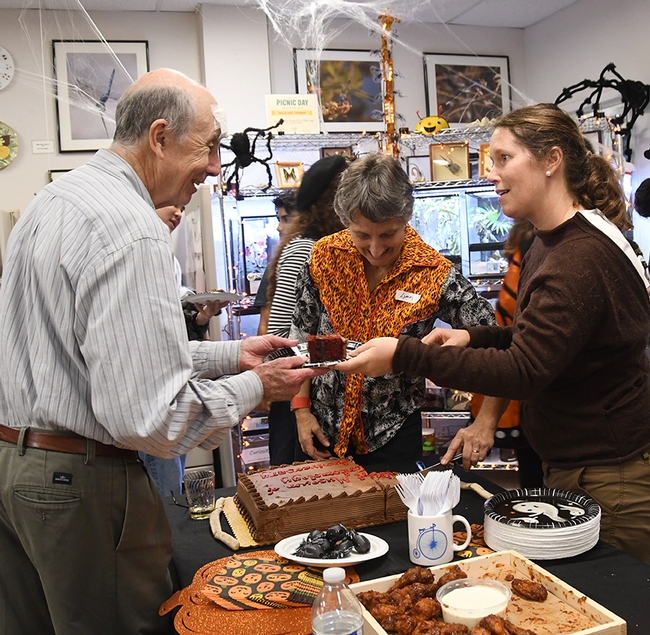
- Author: Kathy Keatley Garvey
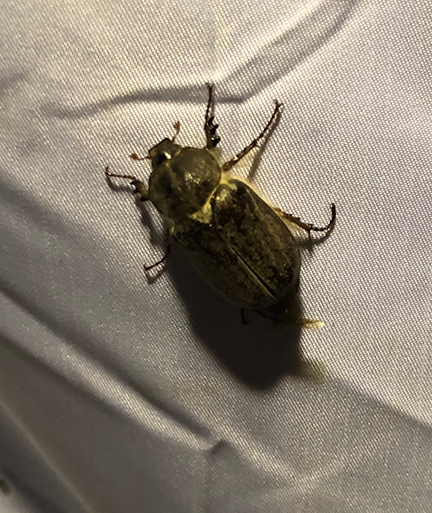
The UC Davis event took place from 8 to 11 p.m. Saturday, July 21 in celebration of National Moth Week, July 21-29, which celebrated the beauty, life cycles and habitats of moths.
Entomologists use the blacklight to collect or view night-flying insects attracted to ultraviolet light. The Bohart associates set up two displays near the Bohart, but the one set up along a UC Davis Arboretum path drew the most moths--and the most spectators.
Blacklighting is basically comprised of a hanging white sheet, illuminated by ultraviolet (UV) light and powered by a generator.
More than 140 spectators attended Moth Night, held both inside the museum (located in Room 1124 of the Academic Surge Building on Crocker Lane) and outside on the campus grounds.
The scarab beetles or what some folks often call by the common name "June bugs" (referring to certain species of scarabs) showed up first, followed by assorted moths.
Beetle expert Fran Keller, assistant professor at Folsom Lake College who received her doctorate in entomology from UC Davis, identified it as a Polyphylla sp. or lined June beetle. "I think it was a female because the antennae were reduced."
Bohart associate and "Moth Man" John De Benedictis listed the species sighted at Moth Night by family. Among them:
NOCTUIDAE: Spodoptera exigua (Beet Armyworm Moth), Proxenus sp. (probably P. mindara)
GEOMETRIDAE: Prochoerodes truxaliata
PYRALIDAE: Ehestiodes gilvescentella
TORTRICIDAE: Cydia latiferreana (Filbertworm Moth), Grapholita prunivora (Lesser Appleworm Moth)
GELECHIIDAE: Leucogniella sp. (probably L. distincta)
TINEDAE: Oinophila v-flava
ACROLOPHIDAE: Amydria sp. (cannot tell genus or species without dissecting. Likely Pseudopsalta confusella.)
De Benedictis said a young girl collected the Prochoerodes truxaliata, a moth that feeds on coyote bush as a caterpillar.
The Bohart Museum, directed by Lynn Kimsey, professor of entomology at UC Davis, houses a global collection of nearly eight million specimens. It is also the home of the seventh largest insect collection in North America, and the California Insect Survey, a storehouse of the insect biodiversity. Noted entomologist Richard M. Bohart (1913-2007) founded the museum. It maintains a live "petting zoo," featuring Madagascar hissing cockroaches, walking sticks, tarantulas, and praying mantids. The museum's gift shop, open year around, includes T-shirts, sweatshirts, books, jewelry, posters, insect-collecting equipment and insect-themed candy.
The Bohart Museum's regular hours are from 9 a.m. to noon and 1 to 5 p.m. Mondays through Thursdays. It is closed to the public on Fridays, Saturdays and Sundays and on major holidays. Admission is free. More information on the Bohart Museum is available on the website or by contacting (530) 752-0493 or emailing bmuseum@ucdavis.edu.
(Editor's Note: Stay tuned for photos of the inside activities on Moth Night.)
